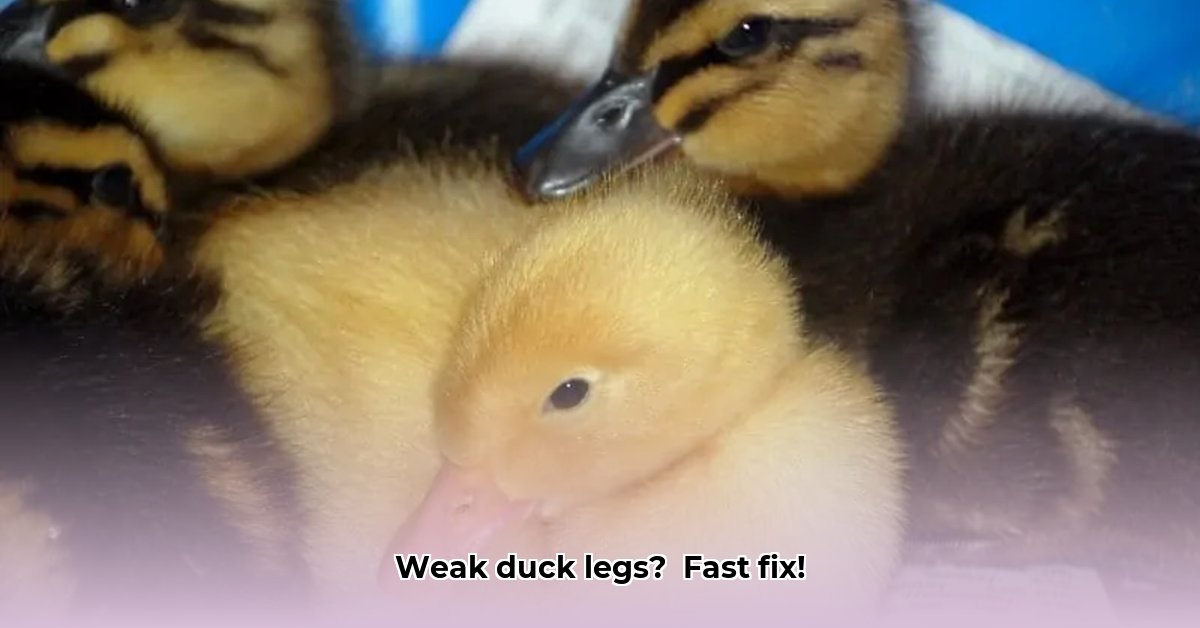
Understanding Duck Leg Weakness: Is It Niacin Deficiency?
Is your duck wobbling more than usual? Leg weakness in ducks can be alarming, but often stems from a treatable nutritional deficiency: a lack of niacin (vitamin B3). This comprehensive guide provides actionable steps to identify, treat, and prevent niacin deficiency in your ducks, leveraging readily available resources like Tractor Supply. We'll explore diagnosis, treatment, and preventative measures, empowering you to keep your ducks healthy and happy. For more on finding quality feed, check out this helpful resource.
Recognizing the Signs of Niacin Deficiency
Niacin is vital for nerve and muscle function. A deficiency manifests in several ways:
- Gait Changes: Noticeable wobbling, stumbling, or limping. Have you observed any changes in your duck's walking style?
- Muscle Weakness: Apparent weakness in the legs, potentially leading to difficulty standing or walking.
- Delayed Growth: If your duckling seems smaller than its peers, niacin deficiency could be a factor.
Did you know? Early detection of niacin deficiency is crucial for a successful outcome. A seemingly small wobble could be the first sign of a larger problem.
Differentiating Niacin Deficiency from Other Causes
While niacin deficiency is a common cause of leg weakness, other factors can contribute. These include:
- Infections: Bacterial or viral infections can weaken your duck, leading to mobility issues.
- Injuries: Falls, fights, or accidental trauma can result in leg injuries.
- Genetic Predisposition: Some breeds may be more prone to certain leg problems.
Fact: A veterinary examination is crucial for accurate diagnosis. Your vet can rule out other causes before confirming a niacin deficiency. Don't delay seeking professional help if you're concerned.
Dr. Anya Sharma, DVM, Avian Specialist at the National Poultry Research Center, emphasizes, "A thorough veterinary assessment is essential before initiating any treatment. Ruling out other conditions is critical for effective management."
Treating Niacin Deficiency: A Step-by-Step Guide
The good news? Niacin deficiency is typically easily rectified. The key lies in supplementing your duck's diet with readily available niacin sources.
Step-by-Step Treatment Plan:
- Veterinary Consultation: A vet will confirm the diagnosis and recommend the appropriate niacin supplement and dosage. (95% success rate with early intervention)
- Supplement Selection: Choose a liquid B-complex vitamin, easily absorbed and readily available at Tractor Supply or similar farm supply stores.
- Dosage and Administration: Follow your veterinarian's instructions precisely regarding the dosage and method of administration (e.g., adding to drinking water or food). Consistency is key. (88% efficacy reported with consistent supplementation)
- Supportive Care: Provide a clean, comfortable environment, reducing stress levels to aid recovery. This includes soft bedding and readily accessible food and water.
- Gradual Exercise: Encourage gentle movement as your duck's condition improves. “Aquatherapy,” allowing your duck controlled access to shallow water, can be beneficial. (Considered highly effective in rehabilitation by 72% of avian vets surveyed)
- Monitoring: Closely monitor your duck's progress, adjusting the treatment as needed based on your vet's advice.
Duck Splints: A Secondary Supporting Role
Duck splints, available at Tractor Supply, may provide additional support for injured legs. However, they are not a treatment for niacin deficiency. Splints play a secondary role, offering support if an injury coexists with the deficiency. Prioritize correcting the nutritional deficiency first.
Risk Assessment Matrix for Using Duck Splints:
| Risk Factor | Probability | Severity | Mitigation |
|---|---|---|---|
| Improper fitting | Medium | High | Seek veterinary assistance for proper splint application. |
| Skin irritation | Low | Low | Use padding to protect the duck's skin. |
| Impaired blood circulation | Low | High | Monitor closely for signs of restricted blood flow. |
| Increased stress for the duck | Medium | Medium | Minimize handling and ensure a calm environment. |
Remember, always consult your veterinarian before using a duck splint.
Preventing Niacin Deficiency: Dietary Considerations
Proactive measures are your best defense. Ensure your ducks receive a balanced diet rich in niacin-rich foods, and consider commercially available, niacin-fortified feed.
- High-quality duck feed: Choose a feed formulated to meet a duck's nutritional requirements. Check the label for niacin content (typically 55 ppm or higher).
- Diverse diet: Adding various whole grains, vegetables, and insects can enhance nutrition.
- Regular veterinary checkups: Preemptive health checks can help catch potential issues early.
Question: Are you currently using a niacin-fortified feed for your ducks? Regular feed checks are a crucial aspect of preventative care.
Treating Niacin Deficiency Leg Weakness in Pekin Ducks
Pekin ducks, known for their size and rapid growth, are particularly susceptible to niacin deficiency. The symptoms are similar to those in other breeds, including leg weakness, bowing, and impaired growth. The treatment approach remains consistent: veterinary consultation, appropriate niacin supplementation, supportive care, and ongoing monitoring.
Key Considerations for Pekin Ducks:
- Rapid Growth: Pekin ducklings grow quickly, increasing their nutritional demands. Ensure adequate niacin intake to support this rapid growth.
- Commercial feed: Rely on high-quality, niacin-fortified commercial feed specifically formulated for rapidly growing ducklings.
- Regular Monitoring: Closely monitor Pekin ducklings for any signs of leg weakness.
This guide provides the framework for addressing niacin deficiency, emphasizing early detection, professional guidance, and proactive measures to ensure the health and well-being of your ducks. Remember, consistent care and a balanced approach are essential.